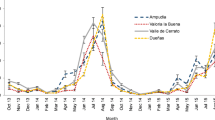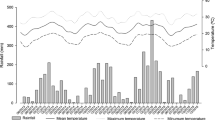Abstract
A major goal for sustainable forestry management is to prevent a decline in soil fertility over time. The impact of phosphorus (P) and potassium (K) fertilization on the nutrients in the foliage, standing litter and topsoil (0 to −10 cm) at the end of the third crop rotation (at age 15 years) was determined. Three quantities (20/20, 40/40 and 80/80 kg ha−1) of both P and K fertilizer was applied at different stages of stand development (all at planting, all post-pruning at age 5 years, or applying 20/20 at planting and the rest post-pruning). The results showed that the effect of P fertilizer was more pronounced than the effect of K fertilizer. Compared to the control, the application of 80/80 PK fertilizer increased the concentration of plant available P (Bray II) in the first −10 cm of the topsoil from 3 to 12 mg P kg−1 and increased the foliar P level to 0.13%. The foliar P as well as the concentration of plant available P in the topsoil increased when the fertilizer was applied post-pruning. The split application of either 40/40 or 80/80 PK fertilizer increased the stemwood P concentration by 50%, compared to the 23 mg P kg−1 on the control plots. Application of the 40/40 and 80/80 quantities of fertilizer increased the dry mass (DM) of the standing litter layer by 27 Mg DM ha−1 (35%), which also affected the P and K content per hectare. A larger proportion of the applied fertilizer-K than fertilizer-P was removed from the site in stemwood and stembark, indicating that the re-application of K in the subsequent rotations will be important for sustainable production.



Similar content being viewed by others
References
Ballard R (1974) Use of soil testing for predicting phosphate fertiliser requirements of radiata pine at time of planting. NZ J Forest Sci 4(1):27–37
Balneaves JM, Dyck WJ (1992) Slash retention a viable option to ensure sustained site productivity? NZ J Forest 37(1):13–16
Barber S (1995) Soil nutrient bioavailability. Wiley-Interscience, New York
Brady NC, Weil RR (1996) The nature and properties of soils. Prentice-Hall International, Inc, Upper Saddle River
Carlson C, Allan R (2001) A pilot study into the above-ground biomass of a mature Pinus patula stand. ICFR Bulletin series 20/2001. Institute for Commercial Forestry Research, Pietermaritzburg
Comerford NB, McLeod M, Skinner M (2002) Phosphorus form and bioavailability in the pine rotation following fertilization. P fertilization influences P form and potential bioavailability to pine in the subsequent rotation. Forest Ecol Manage 169:203–211
Crous JW, Morris AR, Scholes MC (2007) Effects of residual phosphorus and potassium fertiliser on organic matter and soil nutrients in a Pinus patula plantation. Aust Forest J 70(3):200–208
Crous JW, Morris AR, Scholes MC (2008) Growth and foliar nutrient response to recent applications of phosphorus (P) and potassium (K) and to residual P and K fertiliser applied to the previous rotation of Pinus patula at Usutu, Swaziland. Forest Ecol Manage 256:712–721
Crous JW, Morris AR, Scholes MC (2009a) Effect of phosphorus and potassium fertiliser on tree growth and dry timber production of Pinus patula on gabbro-derived soils in Swaziland. South Forests 71(3):235–243
Crous JW, Morris AR, Scholes MC (2009b) Effect of phosphorus and potassium fertilizer on stem form, basic wood density and stem nutrient content of Pinus patula at various stem heights. Aust Forest 72(2):99–111
Dames J, Scholes MC, Straker CJ (2002) Nutrient cycling in a Pinus patula plantation in the Mpumalanga province, South Africa. Appl Soil Ecol 20:211–226
Donkin MJ, Pearce J, Chetty PM (1993a) Methods for routine plant analysis in the ICFR laboratories. ICFR Bulletin 06/93. Institute for Commercial Forestry Research, Pietermaritzburg
Donkin MJ, Pearce J, Chetty PM (1993b) Methods for routine soil analysis in the ICFR laboratories. ICFR Bulletin Series 8/93, Institute for Commercial Forestry Research, Pietermaritzburg
Dyck WJ, Beets PN (1987) Managing for long-term site productivity. NZ J Forest 32(3):23–26
Evans J (1978) A further report on second rotation productivity in the Usutu forest, Swaziland. Commonw Forest Rev 57(4):253–261
Evans J (2005) Growth rates over four rotations of pine in Swaziland. Int Forest Rev 7(4):305–310
Flinn DW, James JM, Hopmans P (1982) Aspects of phosphorus cycling in radiata pine on a strongly phosphorus-adsorbing soil. Aust Forest Res 12:19–35
Hafez AAR, Stout PR (1973) Use of indigenous soil-rubidium absorbed by cotton plants in determining labile soil-potassium pool sizes. Soil Sci Soc Am Proc 33:572–597
Henry PC, Smith MF (2004) A study of kinetics of the adsorption of phosphorus by selected South African soils. S Afr J Plant Soil 21(3):145–151
Jarrell WM, Beverly RB (1981) The dilution effect in plant nutrition studies. Adv Agron 34:197–224
Johnson DW (1983) The effects of harvesting intensity on nutrient depletion in forests. In: Ballard R, Gessel SP (eds) IUFRO symposium on forest site and continuous productivity. USDA Forest Service, Forest and Range Experimental Station, General Technical Report, PNW-163, pp 157–166
Kalra YP, Maynard DG (1991) Methods manual for forest soil and plant analysis. Information report NOR-X-319, Forestry Canada, Northwest region, Northern Forestry Centre, Edmonton
Kuo S (1996) Chapter 32. Total organic phosphorus. In: Sparks DL (ed) Method of soil science analysis. Part 3. Chemical methods. Soil Science Society of America, Madison, pp 874–876
Linder S (1995) Foliar analysis for detecting and correcting nutrient imbalances in Norway spruce. Ecol Bull 44:178–190
Louw JH, Scholes MC (2003) Foliar nutrient levels as indicators of site quality for Pinus patula in the Mpumalanga escarpment area. S Afr Forest J 197:21–30
Madgwick HAI, Webber B (1987) Nutrient removal in harvesting mature Pinus radiata. NZ J Forest 32(3):15–18
Maggs J (1988) Organic matter and nutrients in the forest floor of a Pinus elliottii plantation and some effects of prescribed burning and superphosphate addition. Forest Ecol Manage 23:105–119
Meerts P (2002) Mineral nutrient concentrations in sapwood and heartwood: a literature review. Ann Forest Sci 59:713–722
Morris AR (1986) Soil fertility and long term productivity of Pinus patula in the Usutu Forest, Swaziland. PhD thesis, University of Reading, UK
Morris AR (1987) Recommendations for fertilizer application to Pinus patula stands on the Usushwana igneous complex. Forest Research Document 19/87. Usutu Pulp Company, Swaziland
Morris AR (1992) Dry matter and nutrients in the biomass of an age series of Pinus patula plantations in the Usutu Forest, Swaziland. S Afr Forest J 163:5–11
Morris AR (1995) Forest floor accumulation, nutrition and productivity of Pinus patula in the Usutu Forest, Swaziland. Plant Soil 168–169:271–278
Morris AR (2003) Site and stand age effects on fertiliser responses in Pinus patula pulpwood plantations in Swaziland. S Afr Forest J 199:27–39
Nambiar EKS (1996) Sustained productivity of forests is a continuing challenge to soil science. Soil Sci Soc Am J 60:1629–1642
Nambiar EKS, Kallio MH (2008) Increasing and sustaining productivity in tropical forestry plantations: making a difference through cooperative research partnership. In: Nambiar EKS (ed) Site management and productivity in tropical plantation forests. Proceedings of workshops in Piracicaba (Brazil) 22-26 November 2004 and Bogor (Indonesia) 6–9 November 2006. Center for International Forestry Research (CIFOR), Bogor, Indonesia, pp 205–227
Pallett RN (1990) Forest land types of the Usutu Forest Swaziland. Forest Research Document 4/90. Usutu Pulp Company, Swaziland
Payn T, Clinton P (2005) The environmental footprint of New Zealand’s plantation forests: nutrient fluxes and balances. NZ J Forest 50(1):17–22
Payne RW (2007) The Guide to GenStat® release 10, Part 2 statistics. VSN International, Wilkinson House, Jordan Hill Road
Polglase PJ, Jokela EJ, Comerford NB (1992a) Nitrogen and phosphorus release from decomposing needles of southern pine plantations. Soil Sci Soc Am J 56:914–920
Polglase PJ, Comerford NB, Jokela EJ (1992b) Mineralization of nitrogen and phosphorus from soil organic matter in southern pine plantations. Soil Sci Soc Am J 56:921–927
Ranger J, Tarpult M (1999) Input-output nutrient budgets as a diagnostic tool for sustainable forest management. Forest Ecol Manage 122:139–154
Riekerk H (1983) Environmental impacts of intensive silviculture in Florida. In: Ballard R, Gessel SP (eds) IUFRO symposium on forest site and continuous productivity. USDA Forest Service, Forest and Range Experimental Station, General Technical Report, PNW-163, pp 264–271
Ross T, Du Toit B, Dovey S (2005) Nutrient pools in slash loads in Pinus patula sawtimber and pulpwood stands in South Africa. ICFR Bulletin series 10/2005, Institute for Commercial Forestry Research, Pietermaritzburg
Rubilar RA (2003) Biomass and nutrient accumulation comparison between successive loblolly pine plantations on the upper coastal plain of Alabama. Dissertation, North Carolina State University, Raleigh, North Carolina
Rubilar RA, Allen HL, Kelting DL (2005) Comparison of biomass and nutrient content equations for successive rotations of loblolly pine plantations on an Upper Coastal Plain Site. Biomass Bioenergy 28:548–564
Schőnau APG (1984) Fertilisation of fast growing broadleaved species. In: Grey DC, Schőnau APG, Schutz CJ (eds) Proceedings of the IUFRO symposium on site and productivity of fast growing plantations, vol. 1. Pretoria and Pietermaritzburg, pp 253–268
Shepard JP, Mitchell MJ (1990) Nutrient cycling in a red pine plantation 39 years after potassium fertilization. Soil Sci Soc Am J 54:1433–1440
Simpson WT (1993) Specific gravity, moisture content and density relationship for wood. General Technical Report FPL-GTR-76. U.S. Department of Agriculture, Forest Service, Forest Products Laboratory, Madison
Singh B (1982) Nutrient content of standing crop and biological cycling in Pinus patula ecosystem. Forest Ecol Manage 4:317–332
Smith TE, Osborne DO, Simpson JA (2008) Inter-rotation management impacts on growth and soil properties in hybrid pine plantations on sandy soils in subtropical Australia. In: Nambiar EKS (ed) Site management and productivity in tropical plantation forests. Proceedings of Workshops in Piracicaba (Brazil) 22-26 November 2004 and Bogor (Indonesia) 6-9 November 2006. Center for International Forestry Research (CIFOR), Bogor, Indonesia, pp 139–147
Soil Survey Staff (2006) Keys to soil taxonomy, 10th edn. United States Department of Agriculture. U.S. Government Printing Office, Washington
Tew DT, Morris LA, Allen LH, Wells CG (1986) Estimates of nutrient removal, displacement and loss resulting from harvest and site preparation of a Pinus taeda plantation in the Piedmont of North Carolina. Forest Ecol Manage 15:257–267
Tisdale SL, Nelson WL, Beaton JD, Havlin JL (1993) Soil fertility and fertilizers, 5th edn. Prentice Hall, New Jersey
Troeh FR, Thompson LM (2005) Soils and soil fertility, 6th edn. Blackwell Publishing, USA, p 489
Will G (1985) Nutrient deficiencies and fertilizer use in New Zealand exotic forests. FRI Bulletin No. 97. Forest Research Institute, New Zealand Forest Service, Rotorua
Acknowledgments
Sabelo Khoza, the Usutu Research Team and Milton Nkambule’s Super Research Services assisted with trial measurements and sample collection. The Sappi Forests Research Hardwood Breeding Programme assisted with tree density analysis. Rob Pallett. Arnulf Kanzler, Mbeko Nkosana, Craig Ford and anonymous reviewers provided constructive comments regarding this document. The University of the Witwatersrand, National Research Foundation of South Africa and Sappi provided funding.
Author information
Authors and Affiliations
Corresponding author
Additional information
Communicated by A. Merino.
Rights and permissions
About this article
Cite this article
Crous, J.W., Morris, A.R. & Scholes, M.C. Changes in topsoil, standing litter and tree nutrient content of a Pinus patula plantation after phosphorus and potassium fertilization. Eur J Forest Res 130, 277–292 (2011). https://doi.org/10.1007/s10342-010-0430-z
Received:
Revised:
Accepted:
Published:
Issue Date:
DOI: https://doi.org/10.1007/s10342-010-0430-z




